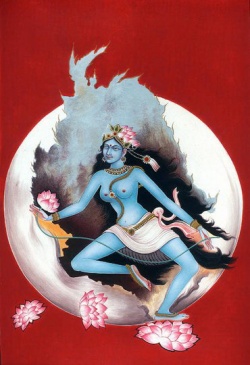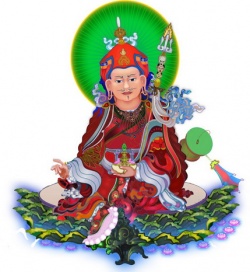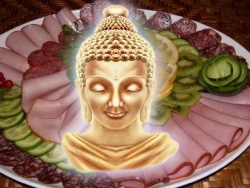Wilber and Adi Da's Nirvanasara
It is fairly clear that even in Integral Spirituality, Ken remains attached to views put forward by Franklin Jones in Nirvanasara.
This is "Nirvanasara," the Essence of the Teaching of Nirvana, or Radical Transcendentalism.
In the Awakening of the seventh stage of life, the self-contraction (or "I") is already and inherently or priorly transcended, and the not-self (or Nature) is thus also inherently or tacitly recognized.
The Way in the seventh stage of life is to Abide in Divine Ignorance, or tacit and prior Identification with Radiant Transcendental or Divine Being, spontaneously recognizing whatever arises (as mind, or phenomenon, or action) in That, until all is forgotten or Outshined in That.
When there is no self-contraction, the Realm of Nature is Obvious as it is. The self-contraction and the entire Realm of Nature are arising as transparent, or merely apparent, unnecessary, and non-binding modifications of the same One Radiant Transcendental Divine Being or Reality! Therefore, transcend the self-contraction via radical understanding until the Awakening of the seventh stage of life, wherein self and not-self are equally and simultaneously transcended and ultimately Outshined in the One that is Love and Happiness and the Peace of Bliss.
Whenever Ken instanciates "causal formlessness" with the "classical nirvana" of Hinayana Buddhism, he basically evokes views put forward in Nirvanasara, though Goleman's reification of Theravada "nirvana" in Varieties of the Meditative Experience can also be said to be at work in Ken's characterization.
As for Nirvanasara, there are, in this book, indeed some rather accute insights and accurate depictions of the Indian tradition's self-understandin. Wilber is perhaps a better systematic thinker than Da, but in many ways, Franklin's insights into, and use of, the Indian tradition outstrip Ken's work; Wilber appears to be aware of this superiority.
In Nirvanasara, Da shows insight into the Indian tradition's understanding of its own movement, in particular, into the self-understanding of Tantrism. This "movement," which is both historical and soteriological, which is described by the Buddhist Tantric tradition, is a dialectical structure basically taken over from the Mahayana.
In most iconic depictions, Nagarjuna is shown making a certain gesture or mudra; Specifically, the mudra is meant to indicate "second turning" of the wheel of dharma. The idea is (even if it were not Nagarjuna's own belief) the Prajnaparamita literature, and its interpretation by the Madhyamika school, constitute a "second turning" of the wheel of dharma.
According to this line of thinking, the teaching of emptiness was too radical for people at the time of the Buddha. And so he did not teach it. But, according to legend, Nagarjuna recovered the teachings in the lairs of the Nagas, deep in the ocean, and brought them back to expound and explicate them.
This idea is clearly an attempt to justify the teachings of the Mahayana, teachings that, when they first appeared would have looked and sounded very different from the received views of the day.
In the Yogachara text, Samdhinirmocana Sutra, we find another application of this idea of "turning the wheel." There, we read that the teachings of the Yogachara constitute a third turning of the wheel of dharma. Here, and in other Yogachara foundational texts, this idea is explicated in accordance with a specific "logic" or dialectic.
This idea can be interpreted as follows: In early or "Hinayana" Buddhism, form is form, or mountains are mountains. In other words, Abhidharma Buddhism, or the first turning, is a form of "realism." In the Prajnaparamita literature, and in Madhyamika, we find the idea that form is in fact empty. As Zen would have it, now mountains are not mountains (ie. mountains are empty). This is the second turning.
But does this mean that everything is empty? The Yogachara could not countenance this idea. Something remains in emptiness, and this something, for the Yogachara, is the contents of consciousness. In place of the Madhyamika conception of emptiness, the Yogachara substitute a specific image: the image of an empty vessel. The Yogachara then identify the empty vessel with its own conception of consciousness. As Ken correctly states in Integral Spirituality, in Yogachara thought this "vessel" is conceived of as a kind of "openness" or "clearing" wherein objects "arise," or come into being. This conception is remarkably close to the conception of consciousness that we find in phenomenology. Indeed, Heidegger himself refers to "the clearing" in his work, though he calls this clearing "Being"; and in the essay, "A Conversation with a Japanese," Heidegger himself explicitly identifies "Being" with the Zen conception of emptiness as "openness."
For the Yogachara, then, objects appear "within" the empty vessel of consciousness, or as the idealistic sub-school would have it, are "projections" (pratibhasa) of consciousness, emptiness and form are no longer radically distinct; the vessel can now be "filled" as it were. This is the third turning.
What the Yogachara does here is substitute the older orientation toward transcendence and discrimination, as found in the Prajnaparamita and Madhyamika, with an emphasis upon immanence and identity. Emptiness, now, IS form, as Ken would have it; or, as Trungpa and Zen would have it, form is form again, and mountains are mountains.
This newer emphasis upon immanence is a different kind of soteriological strategy. Instead of saying that the object must be renounced, we can now say that it no longer need be viewed as an alien presence "impinging" upon us from "outside" as it were. Also implied here is the idea that the emphasis upon immanence is superior. Where the older emphasis had been upon the renunciation of the world and its objects on the grounds of their emptiness, objects are now seen as appearances within consciousness. This idea jibes well with the Tantric idea that it is a superior practice that "lives in the world though not of it."
This supposed "superiority" of immanentism is justified by means of the "logic" or dialectic movement that we find in the Samdhinirmocana. This dialectic can be understood in terms of a circle that moves counterclockwise, first from the bottom, up the left arc toward the top of the circle, then back down. Here, "form is form" is found at the bottom of the circle, while "form is empty" occurs at the top of the circle. Note here that the Madhyamika conception of emptiness is understood as merely a 180 degree turning. This "turning" must, according to this "logic," must be "completed"; it must turn the full 360 degrees and "return" down the right arc back "into" the world" to be "complete." The image of the "wheel" is quite appropo here.
Da is not the only person to note the "logic" of this kind of movement. This "movement" is also described by the Japanese Buddhist scholar Nagao in his various articles on Madhyamika and Yogachara.
This emphasis upon immanence is taken over by the Tantric schools such as the Vajrayana and Kashmiri Shaivism, both of which were heavily indebted to the Yogachara, and melded with the generally "world-centric" orientation of Tantrism. Historically, what the Vajrayana does is take the "three-fold turning" over from the Yogachara and apply it to a kind of "pseudo-historigraphy" so as to justify Tibetan Buddhism. There, inn the self-understanding of Tibetan Buddhism, we find the three "yanas," Hinayana, Mahayana, Vajrayana, where we once found the three "turnings."
Something very similar could be done with the Hindu traditions of Samkhya, classical Advaita Vedanta, and Kashmiri Shaivism. One could probably extract just such a conception from the works of Abhivanagupta, who speaks of the Shaiva Kaula dharma as "transcending and including" all other traditions, including classical advaita vedanta, just as the elephant's footprint obliterates the tracks of all other animals.
Da's use of these ideas in Nirvanasara are not identical to the above, but he makes use of the same dialectical structure. Generally, he speaks of classical Advaita and classical Buddhism as reifying nirvikalpa samadhi and "classical nirvana" (or nirodha if we want to bring Goleman's language into the picture as Ken does). According to Da, these traditions discriminate "nirvana" and nirvikalpa samadhi from the world. Da refers to these two traditions as two poles, one "realistic" and the other "idealistic" (an idea he may have picked up from Western scholars), but he calls both forms of "transcendentalism" and by this I take it that he means to say that both emphasize transcendence over immanence.
In Da's writings, the term "discrimination" becomes a kind of catchword used when referring to "merely six stage" soteriological strategies. This idea, "discrimination" as a kind of "bug-bear, is, I believe, taken over from D.T. Suzuki's translation of the Lankavatara Sutra, a work, it should be noted that has a pronounced Yogachara orientation. Throughout his translation, Suzuki repeatedly translates the term "vikalpa," which loosely means dichotmous or dualistic thinking, with the English term "discrimination." This, as some reviewers have noted, is highly misleading as it does not differentiate vikalpa (bad) from viveka (good). However, in at least one place in the text, the Sanskrit term "viveka" does indeed appear where Suzuki uses the term "discrimination; moreover, the Lankavatara does indeed repudiate viveka at this point. On this count and to this extent, both Suzuki and Da are correct: the general orientation of the Lankavatara is indeed one that emphasizes non-discrimination over discrimination; immanence over transcendence. It was for this reason that Da once called the Lankavatara a "seventh stage" text.
To return to my point about Ken's most recent work, insofar as Ken still remains attached to such conceptions -- which are clearly at work in his conception of "enlightenment" as "union" with objects -- he still remains attached to a specific metaphysical conception and orienttion. To give a specific example, to say that immanence is "superior" to transcendence implies that one accepts the historiography that takes the Vajrayana as "superior" to Mahayana and "Hinayana." Only a tantrika, a Vajrayanist or Kashmiri Shaiva, could say such a thing. For the rest of the tradition, historically speaking, we have been in a state of spiritual decline; this is the Kali Yuga, after all!)
It goes without saying that any such "historigraphy" is by its very nature teleological in nature. And to that extent is remains metaphysical at its core.




